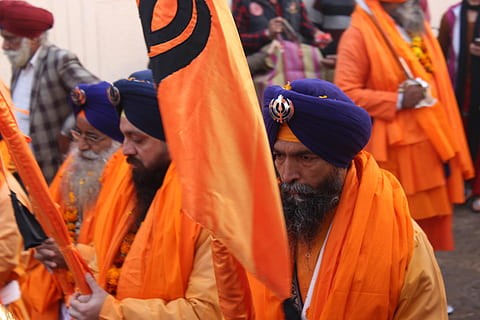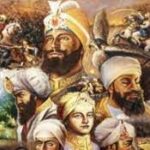In the Khalsa society, the turban signify numerous virtues:-
Equality
The Sikhs community is an egalitarian one, and free of sexual orientation, nationality, race, religion or gender. The institution of Khalsa was build on no master no slave.
Spirituality
The turban is a sign of humility, spirituality, and holiness in Sikhism.
Honour and self-respect
The turban is also a sign of self-respect and honour. In the Punjabi tradition, those who have selflessly served the society are traditionally honoured with dastar.
Piety and moral values
The turban also signify purity of mind and piety. In the Punjabi community, the Khalsa Sikhs are considered as protectors of the weak, even among the non-Sikhs. In the old times, the Khalsa warriors proceeded from village to village at night time, during the battles. When they wanted a place to hide out from the enemy, the womenfolk, who had a very high degree of faith in them used to let them inside their homes.
Courage
Sikhs wear a turban, to shield up their long hair, which is not at all cut, as per the command of their earlier Guru, Guru Gobind Singh. There are numerous references in the Sikh history that explain how Guru Gobind Singh personally tied dastār (dumalas) on the heads of both his elder sons Jujhar Singh and Ajit Singh, and how he in person gave them arms, ornament them like bridegrooms, and mail them to the battlefield at Chamkaur Sahib where they both died as martyrs. A blue-colored dastar is especially identified with martyrdom, courage, and sacrifice.
Friendship and relationship
Pag Vatauni is a Punjabi tradition, in which the men exchange turbans with their immediate friends. Once they exchange dastar they become buddy for life and build a permanent relationship. They take a dignified pledge to share their sorrows and joys under all situations. Exchange out turban is a glue that can bind two human or families together for life lond time and generations.
You have no right to ask a Sikh to remove out his turban. Do not dare to touch a Sikh’s turban. If you ever touch it by fault, apologize immediately. If you do not, depend on the circumstances, the response might be unexpected –
The turban has been an crucial chunk of the Sikh Tradition since the timeline of Guru Nanak Dev. Historical accounts pass on to us that all Sikh Gurus do wore turbans and their followers –Sikhs– have been wearing them since the evolution of the faith. The turban set out as a symbol of commitment to the Sikh Gurus. It pick out a Sikh as an instrument of the Guru and decrees accountability for some temporal and spiritual duties. It is a sign of the Guru and announce that the Sikh wearing a turban is a attendant of the Divine Presence. Wearing the turban offers much inner strength as well. Sikhs take this present of the Guru with them everywhere they go. Just by being display out to this regal quality, their psyche and attitudes get shaped in a certain manner.
At the same time, there is a good deal of responsibility go with by the turban. A humans actions are no longer just tied to her or him. Since Sikhs who wear the turban be elected fir the Guru, their actions too reflect on the Sikh Nation and Guru. In this manner, the turban serves to expand a Sikh’s commitment to Sikhism and lends to her or his becoming a more virtuous and disciplined human. The turban certainly deepens the connection between the Guru and the Sikh. The turban indicates the followers of Guru Nanak as Sikhs but at the same timeline, it is not what makes them Sikhs.








